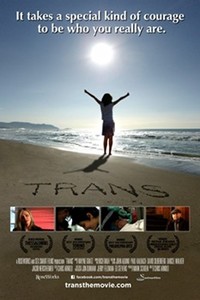Media/Arts
“It’s just that you have to be two people sometimes.” Trans is a documentary that shares the stories of several transgender people in various stages of their lives and their transition, ranging from a 7-year-old to those in middle age. This documentary approaches the trans experience from multiple angles: individuals, parents of trans children, trans parents, friends and partners, and the trans community as a whole. While much of the focus is on the physical elements of being trans and the transition some choose to go undergo, the psychological and emotional aspects are recognized as the underlying impetus. This would be a good film for trans adults if they need a sense that they aren’t alone, and for family and friends of trans individuals to help them understand what their loved one is going through, what it’s like to be trans, and the steps involved to transition, if that’s the ultimate decision. For those unfamiliar with the trans community, this documentary provides a basic understanding of what it means to be trans, the experiences of trans adults as they transitioned from childhood to adulthood, how they realized they were trans, and the challenges that accompany being trans. The documentary also presents the emotional struggles of children who aren’t allowed to present as their identified gender and the outbursts and destructive thoughts that can accompany the pain of not being able to be who you are. The film also sheds light on some false assumptions. It shows that not all trans women play with dolls as children, such as Christine McGinn, who was an honored medical core US Navy officer, and that gender identity and sexual orientation are separate entities. It explores other difficulties that trans people experience that viewers may not have considered, such as when should trans people tell someone they’re dating that they’re trans? Although no real solutions are provided, it shows the depth and variety of complications that come with being trans. Trans looks into the lives of these individuals and highlights the struggles they experience on a personal level and the challenges the community faces, as well as shares success stories and the happiness that can be achieved in living one’s true identity. For social workers unfamiliar with the trans experience, this film provides a peek into that perspective. The documentary emphasizes the fact that, not too long ago, counseling for trans people was about “fixing the problem” and getting trans people to think like “normal” people, while now it involves working on any individual issues, celebrating who trans people are, and supporting them on their journey. There are various resources mentioned that could help guide those who want to learn more about trans culture and experiences, and could be shared with clients to enable self-help and remove the sense of isolation by introducing them to the trans community. In addition to books, centers, and other educational venues, the Internet possibly is the greatest available resource. Not only does it offer clients access to information about transitioning, if that’s an end goal, but it also provides a community of individuals who have undergone similar transitions or have experiential knowledge regarding topics such as surgery, hormones, and how to tell loved ones. This especially is vital to the younger generations who are just beginning to explore their identity. However, the film is lacking in two ways. One downside is that the documentary mostly explores male-to-female individuals. While trans men were interviewed, it was mostly as experts in the field who were commenting from a professional standpoint and typically after they had transitioned, so the viewer never hears their personal stories of transitioning. However, the information is useful as a jumping-off point for social workers to utilize or to guide their clients, whether the client is male-to-female or female-to-male. The one trans man interviewed, who had just begun his journey, seemed to be experiencing a more positive reaction from his loved ones than what those from older generations experienced. This gives the viewer a sense of hope that social change is evolving and will result in a happier future for trans individuals. Something else lacking from the film was representation for trans individuals who don’t start hormones or undergo surgery, whether due to medical reasons or by choice, and how they live and are viewed. This left the portrayal of trans individuals as those who have the surgery and use hormones (no matter how late in life), which is a disservice to the community as a whole. It suggests that the definition of a trans person is limited to, or at least presents it only as, individuals who have undergone or plan to undergo medical procedures to alter their bodies. In that vein, a warning to sensitive viewers: Two surgeries are performed partially on screen. Although nothing gruesome is shown, there are visuals that may be uncomfortable for some viewers. This documentary is a valuable asset both as educational tool and as an outreach film for raising awareness and humanizing an experience that many people may not ever connect to real individuals. — Brandi Redding is the assistant editor of Social Work Today.
A Day of Remembrance |

 A Film Review of Trans
A Film Review of Trans
